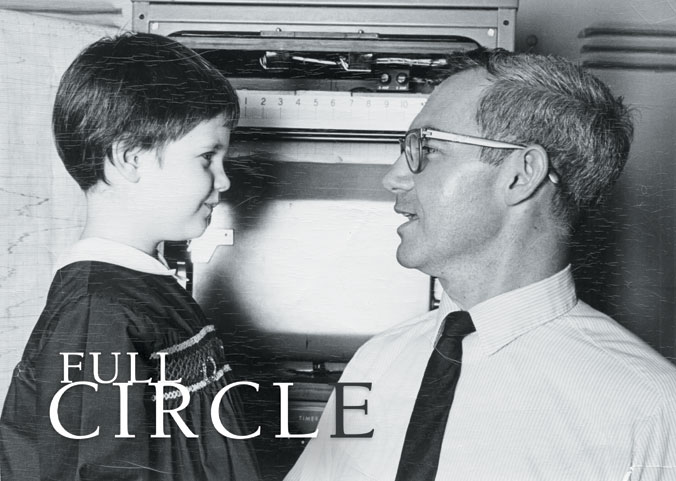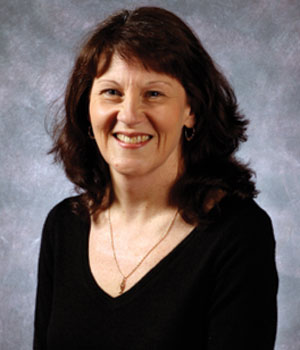 "Wabash Women" events often begin with introductions. Each woman tells her name, her relationship to Wabash, and the length of that affiliation. I love it when I’m near the end. I listen with great interest as I hear "I’ve taught here for eight years...," "My husband has worked here for 17 years...," "I’ve been with the College for 30 years...."
"Wabash Women" events often begin with introductions. Each woman tells her name, her relationship to Wabash, and the length of that affiliation. I love it when I’m near the end. I listen with great interest as I hear "I’ve taught here for eight years...," "My husband has worked here for 17 years...," "I’ve been with the College for 30 years...."
And then, when it’s my turn, I get to say, "I’m Susan Easterling Albrecht. I work in the library, and I’ve been associated with Wabash College for 45 years."
That might not seem exceptionally remarkable except for the fact that I am 45 years old.
My life at Wabash began in 1962, shortly after I was born, when my father, Vern Easterling, took a position here as assistant professor of physics. He went on to teach here for 38 years and then continued, part-time, for a few more years.
My mother Barbara also worked on campus for three decades, first as manager of the Wabash bookstore and then as library acquisitions manager. Even with four kids and two working parents, we needed only one vehicle (an ever-so-stylish powder blue Pinto wagon) for the whole family-everything centered on this place and our schools, which were within walking or biking distance.
So I was a faculty brat who "grew up around this place." As a little kid, I tagged along on Phys-Chem
picnics, went to football and basketball games, watched intramural softball games (which the faculty always won), and spent countless hours on the College tennis courts—taking lessons from another physics department kid, Walt Henry, and members of the mid-70s tennis teams, or just whacking the ball against the brick walls up the steps of the then-side-entrance to the gym on Crawford Street.
ONE OF MY FAVORITE MEMORIES is of visiting my dad in his lab in Goodrich Hall, a small child looking in wonder at all of that equipment, those chalkboards, and all those red and black wires. Professor Paul Mielke ’42 took a number of photos, which we still have, of my dad and me in his office and lab. I must have spent a fair bit of time there, for the scent of the place became embedded in my sensory memory. If I had visited every building on campus blindfolded, I could have told you the instant I stepped inside Goodrich Hall thanks to that pungent scent, chemical-y and yet dusty, too. The recent remodeling of that building has, alas, eliminated that nostalgic aroma.
In high school I worked for the campus food service, then Saga Foods (aka, "Soggy Foods"), caught the occasional sporting event, and attended many plays and lectures. Phyllis Schlafly’s talk was especially memorable, though not because I appreciated her views. Rather, watching and listening to the students in the audience that evening, the vision of what a liberal arts education is all about became more fully reinforced in me.
The summer after my sophomore year of college, I worked in Professor David Polley’s lab, alongside Jim Francoeur ’83 (sadly, recently deceased). We were working with chlamydomonas reinhardi, and I attempted to learn the art of patience while attempting to suck those suckers out of a Petri dish with pipette. I also learned to properly dispose of toluene, which does not quite share the fond place in my olfactory memory as The Goodrich Scent.
OF THE FOUR OF US EASTERLING KIDS, I was the one most bitten by the "teaching bug" I’d seen evidenced in my dad. After Earlham, I remained away from Crawfordsville while attending grad school in Knoxville and Bloomington, and then began a five-year social studies teaching stint at Martinsville High School. The subject matter might have been different from his, but I could appreciate Dad’s experiences, discuss strategies, and share epiphanies and frustrations (right down to groaning about Sunday night grading).
I taught U.S. History. Reading that, most people’s minds perhaps automatically, and probably none-too-fondly, turn to explorers and presidents. Perhaps my "Wabash upbringing" revealed itself in the fact that I didn’t really care about having my students memorize a bunch of dates or to name all the presidents in order. Didn’t matter to me, couldn’t do it myself, frankly. What did matter to me was thinking about the stories themselves, about the incidents, about the impact of events. On one occasion I split my students into groups of four to plan and then act out the 1860 candidate debate between presidential candidates John Bell, John C. Breckenridge, Stephen Douglas, and Abraham Lincoln. To me, that was teaching history—watching students delve into the issues of that particular time, figure out how to present their platform, and try to win a debate based upon what mattered in 1860.
When a student looked at me and said, "I never knew history could be fun," I knew I had gotten something right. It was a Wabash-liberal-arts kind of moment.
 IN 1995, HAVING BEEN MARRIED (in the Wabash Chapel, naturally) and starting a family, I decided to leave teaching and return to Crawfordsville and Wabash, where I took the very same Lilly Library acquisitions job my mother held for so many years. (And yes, that has been a little weird at times.) One of the most attractive things about the position was the opportunity to become reacquainted and re-involved with the Wabash community, not to mention my being comforted by the knowledge that I wouldn’t have to totally leave behind spending time around young adults, the aspect of teaching I had enjoyed most.
IN 1995, HAVING BEEN MARRIED (in the Wabash Chapel, naturally) and starting a family, I decided to leave teaching and return to Crawfordsville and Wabash, where I took the very same Lilly Library acquisitions job my mother held for so many years. (And yes, that has been a little weird at times.) One of the most attractive things about the position was the opportunity to become reacquainted and re-involved with the Wabash community, not to mention my being comforted by the knowledge that I wouldn’t have to totally leave behind spending time around young adults, the aspect of teaching I had enjoyed most.
As both a daughter and a parent, I’ve been pleased to watch my own children’s creativity and love of music develop in part through my dad’s work with James Makubuya’s Instruments and Culture class. Students in that class design and build their own instruments, and my dad crafted many alongside them. His basement workshop is full of really cool drums, thumb pianos, and lyres created right there and played by my kids, especially my son Jackson.
Contemplating my own identity as a "Wabash Daughter," though, my mind flashes to the 1982 NCAA National Championship basketball season. I had taken a year off from Earlham that year, and since I was "back home," my dad and I attended most every game that 1981-82 season together. What a joy it was, getting caught up in the increasingly impressive performances of Metzelaars, Nice, Seward, Holcomb, Beagle and Parker, as Coach Petty’s team advanced on and on, seemingly inevitably, toward that national championship.
Then, two years ago, my daughter Kristen was faced with the daunting task of selecting a topic for her fourth-grade Indiana History project. She chose that 1982 Wabash championship basketball team. It was an adventure, accompanying her as she interviewed Coach Petty, watched some of the championship game tape with him, read through Pete Metzelaars’ emailed responses to her many questions, and pored over documents and photos in the College Archives. Kristen was delighted to discover that Pete’s favorite food is chicken paprikash and that Mac has a triple-decker PBJ before every game. It was of little importance to the project, perhaps, but it made these "legends" human to Kristen.
I now realize that my impressions of most faculty members was tied up with athletics, rather than academics.
I recall my dad playing handball with Bert Stern every week. I picture "Friday Afternoon Doubles" (like the current "Noontime Basketball Association"), made up of Dad, Bill Bonifield, David Hadley, and Peter Wright. I envision George Davis on the tennis court, stopping repeatedly to wring out his sweatbands and to have a smoke.
I now see that my current life as a would-be gym rat, working out at the Allen Center several times a week and attending soccer, basketball and football games with my family, all started back then. New facilities, different courts, same Mud Hollow. A little kid watching and a big kid still watching, I guess, thrilled that her own little kids are watching, too.
AND NOT JUST WATCHING. This is Wabash, after all. So there are guys like Gary Simkus ’08, a two-sport athlete, a very bright young man, and an all-around good guy who doesn’t seem to begrudge my kids the autographs or attention they seek and even thinks to bring them gifts from his travels to Spain and Mexico. I realize that the connections I see happening for them now are like the connections I made in my own childhood here.
IT HAS BEEN A BLESSING to have been so tied to this community for so very long, as a faculty brat daughter, as a kid into watching college sports, as an employee, and now as a parent whose own children are discovering outlets for their interests and talents as staff brats, if not faculty ones. The faculty changes—McKinney, Dean, Williams, Zimmerman, Brooks, Cole, Peebles, Fischer, Easterling have moved on, while Placher, Polley, Rosenberg, Calisch, Hadley, Butler and the Bankarts inch nearer to retirement. But Feller, Royalty, Taylor, Hartnett, Rogers, Axtell, and Aden move in. The students graduate and more arrive. It changes each year...and yet it does not. The exceptional education, the liberal arts focus, the Division III athletic experience, the small-campus life that Wabash represents, all this remains. What there is for a son or a daughter of Wabash to experience, being a part of this place, remains.
I watch my son getting autographs from soccer players and my daughter reading a lesson at the Festival of Lessons and Carols, and it feels as if I have come full circle with Wabash.
Contact Ms. Albrecht at albrechs@wabash.edu